THE DAY RIOTERS STORMED BROOKLYN (1895)
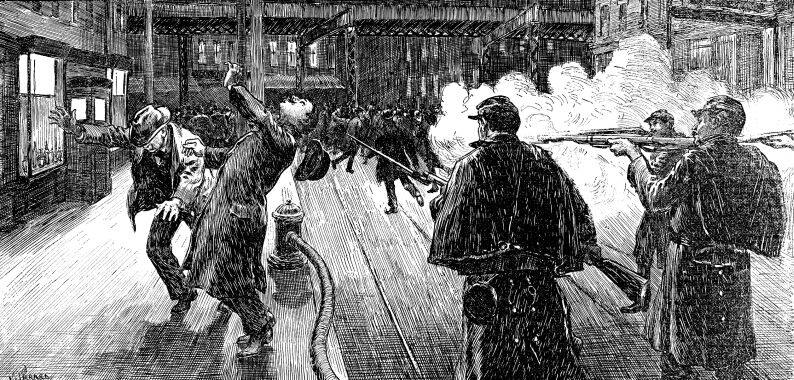
Brownstone Detectives investigates the history of our clients’ homes.
The story you are about to read was composed from research conducted in the course of one of those investigations.
Do you know the history of YOUR house?
********************************************************************************************************************************
(The above picture shows the New York State militia shooting a man on Halsey Street, near the corner of Broadway. You can see the recently erected elevated train line at the end of the block.)
In 1895, Halsey Street near Saratoga Park had become a war zone.
The Brooklyn Streetcar strike had begun on 15 January, and before the week was over the agitation would be in full force. The strike, which began with a walkout, would quickly devolve into a pitched battle between the Knights of Labor and streetcar workers on one side and the streetcar line owners, the police and the New York State Militia on the other.
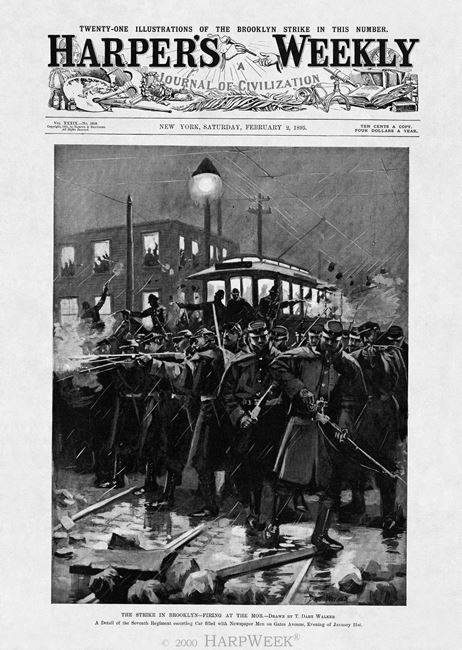
The main focus of much of the strikers’ attention in this part of Brooklyn, though, was the Halsey Street Rail Road Barns. These, located near the corner of Halsey Street and Broadway, were where the streetcar line stored its cars, quartered its horses, and from whence the line’s streetcars were dispatched.
After the workers had called the strike, 5,500 of them would walk off the job for better conditions. The streetcar line owners (the lines were privately owned and operated at the time) countered this strike by calling in scabs who would attempt to operate the streetcars in the workers’ absence. Men from as far away as Pittsburgh began arriving by railway to fill in for the strikers. Others were from the ranks of the local formerly fired streetcar operators, who agreed to the company’s conditions.
This workaround by the streetcar company, as can be guessed, did not sit well with the streetcar workers who grew more and more restless as the days wore on. They began gathering in groups on street corners and forming into extemporaneous mobs to challenge the streetcar operators and then, later, the militia protecting them.
THEN SOMEONE PICKED UP A ROCK…
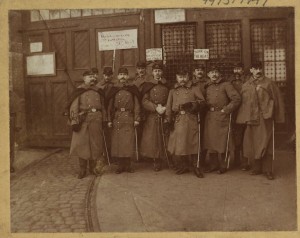
After a few days of this standoff, someone in the crowd of strikers and their sympathizers (which, from news accounts of the time, appeared to be the entire public), an organic gathering that had been growing daily, picked up a rock. Heaving that projectile at a streetcar operator on the Halsey Street Line, the unknown agitator started the panic that would draw in the state militia.
Until this point the streetcars and their car barns had been protected by members of the Brooklyn Police Department. When the militia arrived, however, they relieved the police. As a result, the eastern section of Stuyvesant Heights, at this point, began to take on the veil of martial law.
It was about a week into the strike, though, that things began to really spiral out of control. On the night of 21 January, the 7th Regiment, “for the second time fired a volley” in the direction of the crowd.
“At the Halsey Street stables,” noted one newspaper, “Companies C, F, and K of the 7th Regiment were stationed.” Their job was to protect the property of the streetcar line owners and the lives of their operators as they took their cars into the streets.”
SHARPSHOOTERS AT HALSEY AND HOWARD!
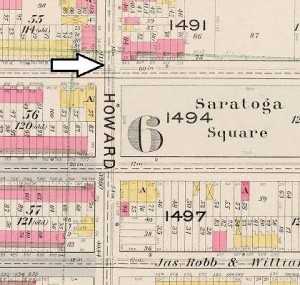
“Capt. Palmer placed 30 picked sharpshooters at Howard Avenue and Halsey Street where a crowd of about 200 jeered them and threw stones and other missiles.
“At about 10 o’clock the men fired a volley, presumably into the air. About 20 shots were fired but so far as can be learned no one was hurt. The mob quickly dispersed.”
It was learned later that there were casualties, but the crowd, though unruly, was adept at spiriting away its wounded.
Two nights later, though, after a period of relative peace, the strikers grew restless once again, and soon both the militiamen and the strikers were on edge. The tenseness was palpable as each side kept a close watch on the other.
Finally, when a gang of men near Halsey and Broadway refused to move when ordered, the militiamen fired at the mob, which, again, quickly dispersed.
In this incident, however, a streetcar operator working for the company was shot through both arms and a wrist. Also, a man by the name of Aherns, who was not likely even involved in the protest effort, was also shot.
THE CHARGE OF THE 7TH REGIMENT
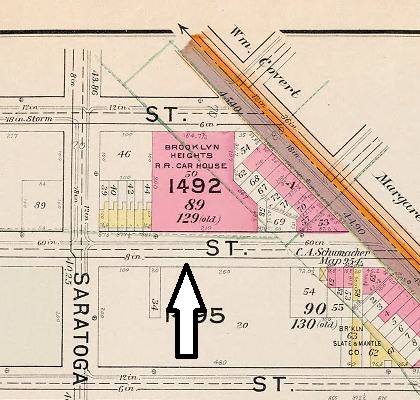
After a few tense moments around the Halsey Street Car Barns where some rock throwing occurred and soldiers rushed crowds of strikers to force their retreat, the rioters began to gather once again around dusk at the corner of Halsey and Broadway.
There was a clear sense that something was going to happen this time. The crowd jeered and taunted the soldiers who stood impassable, almost in good humor at the taunts.
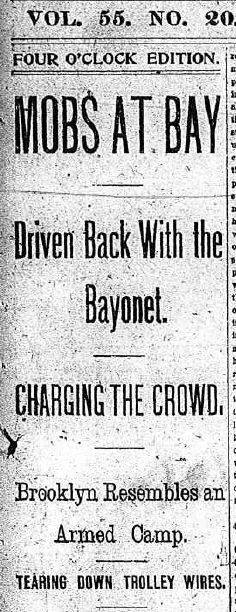
The commander of the regiment, though, sensing the unrest, moved to the front of his men and warned the crowd that his troops would fire if the crowd did not disperse peaceably or if they continued to throw stones at them.
The crowd, though, sensing its potential strength, only grew larger, as it groped for a way to realize its power in the face of an armed opposition. The commander, also realizing the importance of quelling a riot well before it begins, returned to the front line, calmly drew his sword, and shouted an order to his men.
“Charge!”
At this point the soldiers “started on a run toward the crowd.” From this assault, a number of strikers were wounded, but most escaped by fleeing into saloons or other stores that were open.
“There was no further trouble after the charge,” reported a newspaper, “and the neighborhood was deserted.”
Eventually, the pickets called off the strike, having achieved none of their objectives, and they returned to work.
In the end, hundreds of casualties were the result of the streetcar strike. The atmosphere in Stuyvesant East would remain tense for months to come.
———————————————————————————————————————–
 Brownstone Detectives is an historic property research agency. Our mission is to document and save the histories of our clients’ homes. From our research, we produce our celebrated House History Books and House History Reports. Contact us today to begin discovering the history of your home.
Brownstone Detectives is an historic property research agency. Our mission is to document and save the histories of our clients’ homes. From our research, we produce our celebrated House History Books and House History Reports. Contact us today to begin discovering the history of your home.